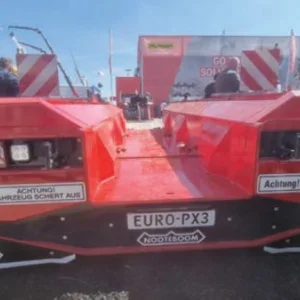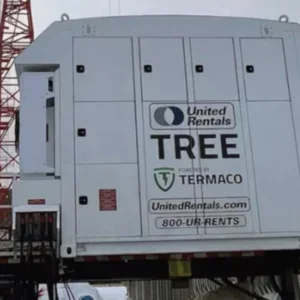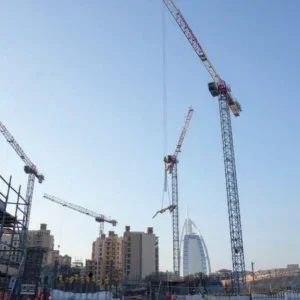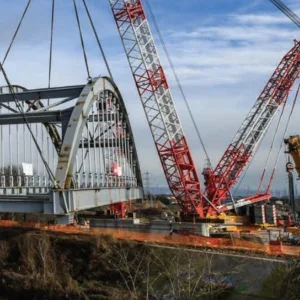The four-storey subterranean Croton Water Filtration Plant is being built to provide cleaner water for New York’s residents. It is the first water treatment plant built within one of New York’s boroughs. It is being built at a 12- acre site in the Bronx. Building the plant has required the excavation of more than 730,000 cu m of earth.
The project was awarded to a joint venture between Skanska and Tully Construction, STJV, in 2007. Worth more than USD1.3bn, it is the largest single construction contract in New York City’s history offered to a single contractor. A project of this size, and limited access, required STJV to add a lot of specialized equipment to its fleet, including the recent purchase of a new Terex HC230 lattice boom crawler crane with a 230 USt lifting capacity for construction of the structure.
An underground facility, the Croton Water Filtration Plant presented STJV with a number of unique challenges. Simply excavating nearly 100ft into the ground presents constant issues with ground water. Another challenge is that STJV needs to complete the civil, structural and mechanical construction and start-up/commissioning of the plant by 12 October, 2011, or the project faces significant penalties.
With the many challenges facing STJV, site access for this underground project is the most monumental. Everything must be taken from ground level and hoisted into “the hole.” All construction details have to be meticulously planned, as the nearly 400,000 sq ft structure is fully enclosed by earth. “We cannot fly equipment into the side of the building like we could if it were built above ground,” says Harold Miller, project manager for STJV.
To meet these challenges, STJV currently employs a variety of cranes, including tower, rough terrain and lattice boom crawler cranes, at the job site. The Terex HC230 lattice boom crawler crane, along with three other crawlers, is positioned at strategic locations at ground level. The rest are working in the hole. “We have enough cranes to provide coverage to every square inch of the building,” explains Brian Cubala, equipment superintendent for STJV. “As we progress, we’ll need more to keep up with the workload.”
Positioned at ground level, the Terex HC230 serves as the critical link between all the supplies at ground level and the hundreds of workers in the hole. Its boom is virtually in constantmotion throughout the day, hoisting whatever is needed— including one million sq ft of wall forms, 100,000 sq ft of concrete slab forms, job boxes, rebar, concrete and tools—to construct the filtration plant structure. The Terex HC230, along with the other cranes at the surface, performs the majority of the critical picks, like hoisting a rough terrain crane into the hole.
Most of the picks performed on this job site by the crawler crane are done in the blind, so the operator must be able to feel the load as the foreman in the pit is directing him. “I like the fact that I can feel the rumble of the auxiliary load hoisting drums, so I get a real sense of the load,” says Jeff Howell, licensed crane operator/operator engineer for Local 14. “If my pit man wants the load moved one-eighth-in, I can give it to him with this crane.”
STJV specifically selected the Terex HC230 for the varied lifting requirements during the four-year Croton Water Filtration Plant construction project. Offering a maximum lift capacity of 230 USt, the machine is among the cranes with the highest capacity on the job site. “STJV needed a 200ft main boom and added the heavy lifting option of the Counterweight Plus package,” says Ron Lado, sales representative for Empire Crane Corp., a Terex Cranes dealer for New York who sold STJV the Terex HC230.
The optional package adds car body counterweight, as well as additional counterweight overlays on the upper, so it can efficiently handle the weight of any pick STJV requires. “The Counterweight Plus package increases the crane’s lift capacity throughout the working range of the machine, giving STJV more operating flexibility,” explains Wendy Knowles, product sales specialist for Terex Cranes. STJV’s crane is equipped with 77in boom with a Hammerhead tip—the Counterweight Plus increases the lifting capacity by 42.4% over the same boom configuration with standard counterweight and offers up to a 33% advantage in the mid-range using the same method of comparison.
The 230 USt Terex HC230 lattice boom crawler includes two identical independent main and auxiliary load hoisting drums. The drums are capable of line speeds up to a maximum of 540- ft/min and 54,060 lb maximum single line pull. “The crane has good line and boom speeds, so it can keep up with the work,” adds Howell. When working with concrete, Howell estimates that the crane can do 65 to 70 yd/hr, which is important since the structure requires nearly 260,000 cu yd of concrete.
An open circuit hydraulic system includes two variable displaced piston pumps to power the travel and hoisting functions. Three gear pumps efficiently power swing, hydraulic gliders and pilot pressure, so multiple functions can be performed simultaneously. “There is no hydraulic stall when I’m doing more than one task at a time, which is a real benefit,” comments Howell.
Delivered on the job site in August 2008, STJV put the Terex HC230 lattice boom crawler crane into action in December. Prior to its start-up, the crane went through New York City approvals before it was put to work. “The City reviews the entire machine—from engineering drawings to the welds to load charts—so the process takes several months,” says Sam Meroney, regional business manager for Terex Cranes. “It’s the same process that all new cranes must go through before working in the City.” Ever since December, “the HC230 has not stopped working,” says Cubala.
No matter how the colossal project is explained, one can hardly comprehend the magnitude of the underground construction project. The Croton Water Filtration Plant structure will require more than one million sq ft of wall forms, enough to cover the entire exterior of the Empire State Building. Over 100,000 sq ft of concrete slab forms will be used, more area than many of the largest sports stadiums around the globe.
Perhaps the most astonishing feature of this project is that by 2012 most New York City residents will not even know it is there. The entire Croton Water Filtration Plant, including lab, filtration area and offices, will be underground. Once completed, the land will be given back to the Mosholu Golf Course, where a driving range will cover most of the Bronx Borough plant site.
New York’s Croton Water System dates back to the mid-nineteenth century, and today, is made up of 12 reservoirs and three controlled lakes located throughout Westchester, Putnam and Dutchess Counties. Croton, the smallest of the reservoir systems, routinely provides 10% of the City’s fresh water and, at certain times, supplies up to 30%.
The Croton Water System is vital to New York City’s drinking water supply. However, substantial development along the system’s watershed has led to problems with storm water runoff, forcing periodic shutdowns of the system.
Development along the system has also caused problems with the US Federal Environmental Protection Agency (EPA). The EPA’s Surface Water Treatment Act requires the supplier of an unfiltered water system to have ownership control of the Water shed. However, the Croton Water System is around 80% sub urbanized, resulting in the need for a filtered Croton water supply.
The HC230 is helping the contractor stay ahead of schedule. “By completing 40% of the structure’s concrete by the end of December, we beat the first of two major contract milestones by more than three months,” says Miller.
By October 2011, New York City residents will have filtered water to drink for the first time in the City’s history. The Croton Water Filtration Plant will supply 292 million gallons of fresh water per day and reliably be able to supply up to 30% of the water needs of New York City.






